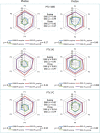Comparison of supine or prone crawl photon or proton breast and regional lymph node radiation therapy including the internal mammary chain
- PMID: 30894606
- PMCID: PMC6427000
- DOI: 10.1038/s41598-019-41283-1
Comparison of supine or prone crawl photon or proton breast and regional lymph node radiation therapy including the internal mammary chain
Abstract
We report on a dosimetrical study comparing supine (S) and prone-crawl (P) position for radiotherapy of whole breast (WB) and loco-regional lymph node regions, including the internal mammary chain (LN_IM). Six left sided breast cancer patients were CT-simulated in S and P positions and four patients only in P position. Treatment plans were made using non-coplanar volumetric modulated arc photon therapy (VMAT) or pencil beam scanning intensity modulated proton therapy (IMPT). Dose prescription was 15*2.67 Gy(GyRBE). The average mean heart doses for S or P VMAT were 5.6 or 4.3 Gy, respectively (p = 0.16) and 1.02 or 1.08 GyRBE, respectively for IMPT (p = 0.8; p < 0.001 for IMPT versus VMAT). The average mean lung doses for S or P VMAT were 5.91 or 2.90 Gy, respectively (p = 0.002) and 1.56 or 1.09 GyRBE, respectively for IMPT (p = 0.016). In high-risk patients, average (range) thirty-year mortality rates from radiotherapy-related cardiac injury and lung cancer were estimated at 6.8(5.4-9.4)% or 3.8(2.8-5.1)% for S or P VMAT (p < 0.001), respectively, and 1.6(1.1-2.0)% or 1.2(0.8-1.6)% for S or P IMPT (p = 0.25), respectively. Radiation-related mortality risk could outweigh the ~8% disease-specific survival benefit of WB + LN_IM radiotherapy for S VMAT but not P VMAT. IMPT carries the lowest radiation-related mortality risks.
Conflict of interest statement
Ghent University is the applicant of the patent entitled Radiotherapy Board and Couch [WO2015144654A1] filed on 25.03.2014. Inventors are Wilfried De Neve, Bruno Speleers, Bert Boute and Liv Veldeman. Status of the patent: pending. The patent applies to the Prone Crawl Breast Couch used in this study.
Figures




Similar articles
-
Whole breast and regional nodal irradiation in prone versus supine position in left sided breast cancer.Radiat Oncol. 2017 May 26;12(1):89. doi: 10.1186/s13014-017-0828-6. Radiat Oncol. 2017. PMID: 28549483 Free PMC article.
-
Treatment planning comparison of IMPT, VMAT and 4π radiotherapy for prostate cases.Radiat Oncol. 2017 Jan 11;12(1):10. doi: 10.1186/s13014-016-0761-0. Radiat Oncol. 2017. PMID: 28077128 Free PMC article.
-
Effects of deep inspiration breath hold on prone photon or proton irradiation of breast and regional lymph nodes.Sci Rep. 2021 Mar 16;11(1):6085. doi: 10.1038/s41598-021-85401-4. Sci Rep. 2021. PMID: 33727599 Free PMC article. Clinical Trial.
-
Estimated Doses to the Heart, Lungs and Oesophagus and Risks From Typical UK Radiotherapy for Early Breast Cancer During 2015-2023.Clin Oncol (R Coll Radiol). 2024 Sep;36(9):e322-e332. doi: 10.1016/j.clon.2024.05.002. Epub 2024 May 6. Clin Oncol (R Coll Radiol). 2024. PMID: 38853062 Free PMC article.
-
Clinical controversies: proton therapy for pediatric tumors.Semin Radiat Oncol. 2013 Apr;23(2):97-108. doi: 10.1016/j.semradonc.2012.11.008. Semin Radiat Oncol. 2013. PMID: 23473686 Free PMC article. Review.
Cited by
-
Four irradiation and three positioning techniques for whole-breast radiotherapy: Is sophisticated always better?J Appl Clin Med Phys. 2022 Nov;23(11):e13720. doi: 10.1002/acm2.13720. Epub 2022 Sep 15. J Appl Clin Med Phys. 2022. PMID: 36106550 Free PMC article.
-
ESTRO-ACROP guideline for positioning, immobilisation and setup verification for local and loco-regional photon breast cancer irradiation.Tech Innov Patient Support Radiat Oncol. 2023 Sep 12;28:100219. doi: 10.1016/j.tipsro.2023.100219. eCollection 2023 Dec. Tech Innov Patient Support Radiat Oncol. 2023. PMID: 37745181 Free PMC article. No abstract available.
-
Safely achieving single prolonged breath-holds of > 5 minutes for radiotherapy in the prone, front crawl position.Br J Radiol. 2021 Jun 1;94(1122):20210079. doi: 10.1259/bjr.20210079. Epub 2021 Apr 29. Br J Radiol. 2021. PMID: 33914612 Free PMC article.
-
Arms positioning in post-mastectomy proton radiation: Feasibility and development of a new arms down contouring atlas.Phys Imaging Radiat Oncol. 2020 May 26;14:6-11. doi: 10.1016/j.phro.2020.04.003. eCollection 2020 Apr. Phys Imaging Radiat Oncol. 2020. PMID: 33458307 Free PMC article.
-
Dosimetric analysis of six whole-breast irradiation techniques in supine and prone positions.Sci Rep. 2024 Jun 21;14(1):14347. doi: 10.1038/s41598-024-65461-y. Sci Rep. 2024. PMID: 38907042 Free PMC article.

